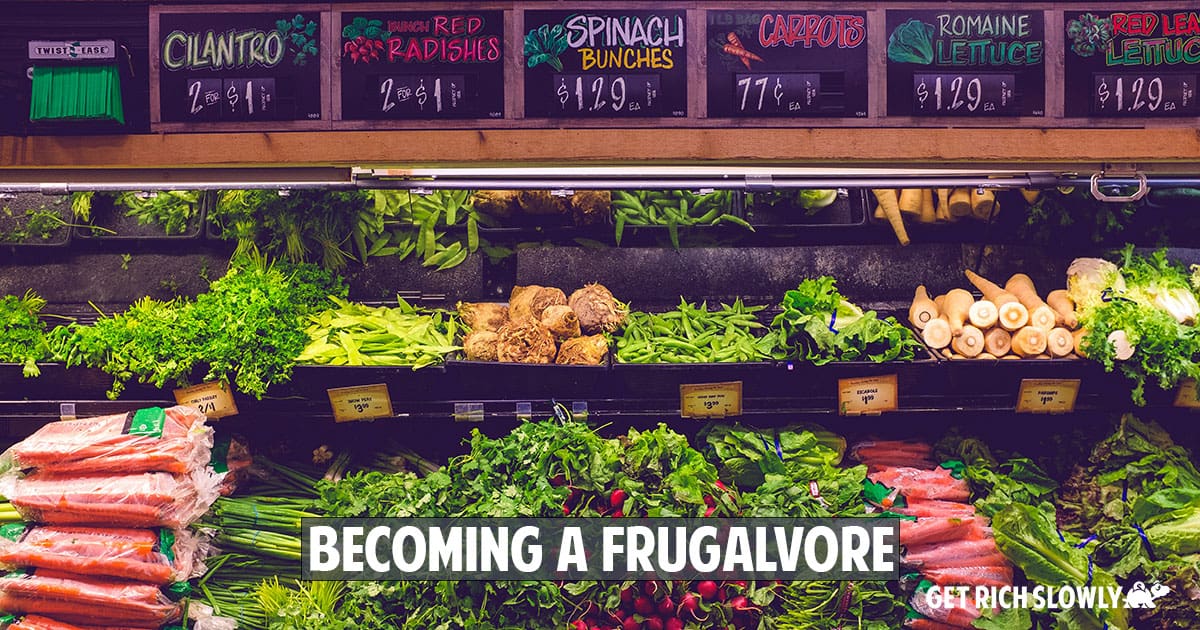Becoming a frugalvore: How to eat well for less

Hey hey, y’all. Here’s an article from former GRS staff writer (and perennial reader favorite) Donna Freedman. This piece about becoming a frugalvore contains material that originally appeared at Donna’s site, Surviving and Thriving. It’s been modified for GRS. Enjoy!
The “locavore” movement is based on the idea of eating only foods grown within a 100-mile radius of where you live. Vicki Robin, for instance, might be best-known for her money manual Your Money or Your Life, but she also wrote a book for locavores in which she advocates a ten-mile diet.
I’m not a locavore but I have my own system, and I think it deserves its own name: I’m a “frugalvore”. Becoming a frugalvore is pretty simple. You shop mostly (or completely) for what’s on sale.
This isn’t exactly a new idea. Plenty of people shop that way their whole lives. But it might be new to you if you grew up in a home where no one read the supermarket ads, created menus, and then worked to get the most bang for each grocery buck.
Becoming a frugalvore both simplifies and complicates your approach to eating.
On the one hand, it’s easier to shop because you plan menus around that week’s most affordable foodstuffs. However, if you’re the kind of person who always shopped by grabbing whatever looked good, then you’ll need to rethink your supermarket habits.
Fortunately, it’s fairly simple. Not always easy, but simple. Here’s how you can become a frugalvore.
Read the Ads
Again, the point of being a frugalvore is to buy what’s on sale whenever possible. To know what’s on sale, you have to read the ads that come in the mail (instead of pitching them directly into the recycling). Pay special attention to loss leaders.
A loss leader is an item with an irresistible price that gets you into the store, at which point you’re likely to buy other stuff. This a simple and effective marketing strategy for supermarkets unless you, the customer, are:
- Frugal, and
- Have enough time to cherry-pick deals at more than one place.
There are two supermarkets in our area. We shop mostly at one chain because it has the best overall best prices. But we keep an eye on the other store’s ads. If there’s a truly skookum deal on chicken thighs or bananas, we might head over. The two retailers are fairly close together so it’s not exactly out of our way.
Maybe you’ve got more than two options. Lucky you! If you don’t have time to read and cross-reference four or five (or more) stores, then obviously you’d go with the one(s) with consistently good prices.
Speaking of which…
Keep a Price Book
Some people can keep average prices in their heads. When they see a “sale” price on cold cereal or canned tomatoes that they know is actually only a few cents off the normal price, it’s not the time to stock up.
If you can remember prices, great! Skip to the next section.
But if you find it hard to remember what Rice Krispies or green beans should cost, create a spreadsheet or carry a small notebook with the general cost of the foods you eat most often. Or download an app. (I don’t use one so I can’t recommend any, but do a search for “price book app” and read the user reviews.)
Create a Menu
Don’t just read the ads. Ask yourself, “What’s on sale that we like to eat?”
Here’s where the internet comes in handy. Look up recipes and/or google each week’s loss leaders (plus the contents of your larder) to come up with affordable, delicious menus.
The good news is that shopping and cooking can actually be fun; you needn’t spend countless hours doing either one (especially if you search on terms like “meals under 20 minutes”). Even if you never become a superb cook, the typical person can feed herself (and anyone else who lives with her) quite well with a relatively small outlay.
Check for Unadvertised Specials
Remember: Not all sales are advertised. For frugalvores, unadvertised specials can be like winning the lottery.
Look for “manager’s special” or “closeout” stickers on shelves. But also check for unadvertised specials in these departments:
- Dairy. Half-price milk means my homemade yogurt is even cheaper. We’ve also learned to look for “hand-picked eggs”: When some dozens are damaged, the employees make up new (and much cheaper) collections from the un-cracked cackleberries.
- Baked goods. If there’s an in-store bakery, chances are you’ll be able to get day-old discounts on rolls, breads, cookies and the like.
- Clearance. Many supermarkets maintain a section in the back of the store (often near the door to the stockroom) with discontinued and ding-and-dent items. Sometimes this means seriously dented cans, which I judge via the USDA standard: Pass on any cans with dents so deep you can lay a finger in them. But some of the cans are only slightly affected. Other items found there are seasonal items at fire-sale prices, or a package that was slightly damaged.
- Meat. Meat is perishable, so it’s frequently discounted. Recently, my DF (“dearest friend”) stopped at Safeway for a special price on milk and bananas, through their JustForU program. To his shock, he found one-pound chubs of ground beef for 99 cents each. This was 93 percent lean beef, too – not the fattier kind. We’ve gotten ground turkey, bratwurst, and other meats at fire-sale prices, too. We use or freeze it right away.
The lesson here? Ads are a great way to find sale items, but they’re not the only way. Learn how and where your local market hides unadvertised specials.
For example, in late December I saw a bin full of ramen for 10 cents a pack. While ramen isn’t the healthiest food on Earth, it makes an okay lunch now and then (especially if I add some vegetables and leftover chicken, if we have any). I bought more packages than I care to recall, but dropped lots of them off at my niece’s house and donated a bunch more to the food bank.
I have no idea why the ramen was that cheap. But I wasn’t going to turn my back on a 10-cent lunch.
J.D.’s note: I make frequent use of both the clearance section and the discounted meat at my local supermarket. Browsing the clearance section is a fun way to find new foods to try.
Learn the Sales Cycles
Keep in mind that some items are discounted seasonally, such as frozen foods in March, eggs in April, dairy items in June, canned goods in September, and turkeys in November. But non-seasonal deals are what make up most of a frugalvore’s cart.
The true grocery cognoscenti know how to follow the “sales cycles”. Many popular items/brands go on sale about every twelve weeks (or sooner). If you know that your household goes through a box of cornflakes per week, then buy enough to get you through until the next sales cycle.
Obviously you wouldn’t refuse to buy a needed staple, especially if it’s one that goes on sale relatively rarely. If I’m out of pepper jack cheese, it’s unlikely that I’ll wait until the next sale cycle or loss-leader price. Of course, it’s also likely that I stocked up during the last big sale.
Frugalvore Hacks
This article can’t list every possible frugal tip, of course, but here are a handful of other helpful hints.
- Make use of your store loyalty card. Get discounts with it. Download coupons to it. Earn points with it. My DF uses the Just4U program through Safeway to get us decent prices on staples like milk and bananas, and when he earns enough Just4U points he can trade them in for certain grocery items.
- Take advantage of other discounts. Every first Tuesday of the month, we over-55s enjoy 10% off Kroger brands at Fred Meyer. There’s also Military Tuesday. I know that different stores offer different discounts on different days. If you qualify for any of these discounts, take advantage of them.
- Watch for promos. A free gallon of milk if you buy four boxes of cereal! A bottle of barbecue sauce with the purchase of certain meats! Buy one/get one free on whatever!
- Use coupons. Fewer physical coupons exist nowadays, but sometimes they’re available in tiny machines with blinking lights (a.k.a “blinkies”) or they’re attached to products. You’re much more likely to be able to download them directly to your store card from the store’s website or from a site like Coupon Mom. (I like Coupon Mom. She does coupon/sales matchups for supermarkets, drugstores, and dollar stores in every state. Let her do the work for you!)
- Think outside the box. Coupon Mom includes deals at dollar stores and supermarkets – so shop there. I’ve found discounted/last-chance bins in both types of emporia, which led to deals like a roll of plastic wrap for 50 cents and four-packs of toilet paper for a quarter. Groceries aren’t always about food, after all. But both emporia also put food items out as loss leaders, and in the case of dollar stores always have some pretty good deals, such as a pound and a half of macaroni for a buck.
- Earn rebates. Coupon Mom also matches Ibotta rebates to those coupon/sales deals. I’d also suggest downloading the Fetch Rewards and Shopkick apps, and earning points that way as well. Some of the deals are for free items, which I use either for holiday stockings/Easter baskets or donations to the food bank. You can trade the points for gift cards or cash.
- Be flexible. Maybe you’ve written “whole fryers” on your shopping list but once in the store you see 99-cent-a-pound pork loin. It’s okay to change gears. You can get the chicken anyway if the price is good. But you could also rewrite some of that week’s menu and load up on pork loin (as much as will fit in your freezer).
As I said, there are many other ways to eat well for less but I don’t want to overwhelm you. You can find more tips for frugal food shopping here at Get Rich Slowly or at my own site, Surviving and Thriving.
Becoming a Frugalvore
Is it easy to become (and remain) a frugalvore? Not always. And it definitely won’t be as easy as grabbing a precooked chicken or ordering takeout.
But keep in mind that until fairly recently, people generally cooked most or all of their meals at home. Yes, we’re a busy nation. Sure, that rotisserie bird looks delicious – and, more to the point, it’s ready to eat.
However, those on tight budgets generally don’t have the luxury of spending the majority of their food dollars on prefab grub. And even those with some disposable income should consider frugalvorism at least some of the time.
What we choose to buy and eat has consequences. Dollars spent on the priciest beef or the out-of-season tomatoes flown in from Israel are dollars that can’t support our long-term goals.
So try this mantra: If it’s not on sale, it’s not in my cart. Say it as often as you need to until frugalvorism becomes automatic. This isn’t penury. It’s prudence.
Donna doesn’t just keep an awesome frugality blog. She has also written two books. The PDF versions are available to GRS readers for $5 each: Your Playbook for Tough Times (discount code
GRS1) and Your Playbook for Tough Times, Vol. 2 (discount codeGRS2).
Become A Money Boss And Join 15,000 Others
Subscribe to the GRS Insider (FREE) and we’ll give you a copy of the Money Boss Manifesto (also FREE)


